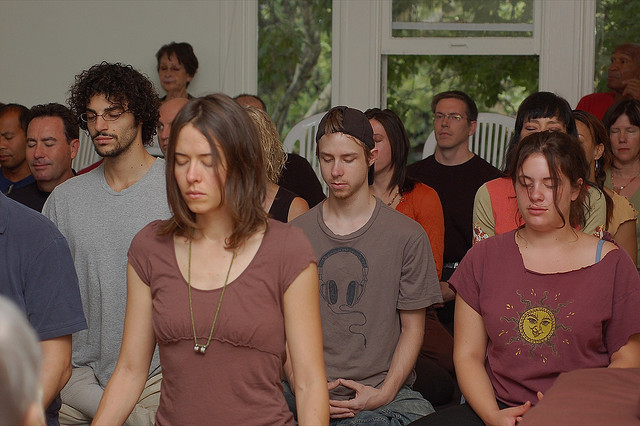Before attending my first guided meditation class, I pictured myself sitting in an uncomfortable cross-legged position chanting om with others while trying to breathe deeply and clear my mind. But after six guided meditation classes, here are six things I’ve learned:
There’s no right or wrong way to do it
Walking into my first guided meditation class, I felt anxious. Where do I sit? How do I sit? What do I sit on? “There’s no right or wrong way,” I heard from across the room. Lie down, sit cross-legged, sit in a chair, do whatever feels the most comfortable.
You don’t have to force anything when you’re meditating. Even when you set aside dedicated time to meditate, you’re going to have off days. There will be days when you can’t get comfortable, certain thoughts won’t exit your mind or you can’t feel or picture what the teacher is telling you to feel or picture. That’s okay. Let go of your expectations and accept what comes.
Thoughts and feelings are okay
Meditation means clearing your mind, right? Wrong. In fact, meditation is mind-full-ness.
When you dedicate time to meditation, you’ll start to hear that tiny voice that gets trampled during the day—the voice most of us ignore or override. Think of these thoughts as the rumble strip on the highway. Let them startle and awaken you back to your true purpose. When it’s a negative or unpleasing thought, just say “no, thank you” and keep breathing.
I cried during my first meditation class. Getting emotional is all part of the experience—especially if you’ve been holding on to something for a long time. Meditation will help you release tension, stress, worry and negativity. Let it fill you up and then let it go.
Guided meditation class is like group therapy for the soul
If you take a group class, be prepared to feel connected to others. Sharing insights before and after each meditation really deepens the experience and helps you gain additional perspective.
My favorite part of guided meditation class is when the teacher asks, “What is your intention this evening?” As she goes around the room and asks for each person’s intention, the answers are repetitive and lean toward one overarching goal: peace of mind. We all want reassurance that everything is going to be okay. Meditation helps us get there, if only for a moment. The more you practice, the more you’ll feel it, especially with the support of others.
Perspective, perspective, perspective
Most of our stress and worry is a result of our thoughts—it’s the meaning we’re attaching to a situation. Through meditation, you’ll start to learn how to shift from a head response to a heart response, focusing more on the positive than the negative. You’ll gain perspective and learn ways to cope with certain feelings.
Close your eyes. Think of something that makes you angry. Now picture that anger as a small object. Hold it in your hand. Does it have less power over you knowing you can extend your arm and hold it away from your body or throw it in the trash?
When you feel yourself shutting people out, not pursing your passions or feeling overwhelmed, ask yourself, Who am I being? Who do I want to be? You’ll learn how to be the author of your own story.
Your teacher makes a difference
When you hear your teacher’s voice in your head outside of class, you know you’ve picked the right one. Guided meditation works for me because when my inner thoughts go wild, the outer voice helps me focus. However, much like school professors or bosses, not all teachers are created equal.
I attended classes with three different teachers before deciding on the class I wanted to continue. Each instructor had a different voice, pace and method. One used music to enhance the experience and another provided time to journal between meditations. It was important for me to find a teacher with a soft voice that exuded the joy and peace I aspire to embody. Find someone you connect with and can listen to for an hour or more.
You don’t have to pay a fortune
When I was deciding whether to go to a group retreat, a class or meditate on my own at home, I came across a class with a $1,500 price tag. I found weekend and week-long retreats that cost thousands of dollars too. Wow! Some websites say that if you’re meditating at home, you need a dedicated space with crystals, candles, special blankets and pillows.
If you’re just starting out, look for a local class. Most of the instructors in my area charge $15 to $20 per class. This is a steal for the time and energy they devote to each class. There are also several free mobile apps like Insight Timer or Headspace. When setting up a space at home, just grab a comfortable blanket or pillow, plop yourself on top of your bed or floor and begin.
Meditation doesn’t have to be intimidating or expensive. The most important thing is that you’re comfortable and have the support you need. There’s no right or wrong way. Give it a try!
Author: Alison Guzman
Editor: Evan Yerburgh
Image: Flickr
 Share on bsky
Share on bsky






Read 3 comments and reply